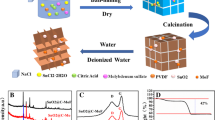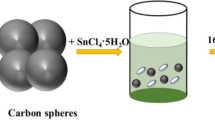Abstract
Sn-based anode materials have gained more attention for application in lithium-ion batteries (LIBs), due to tin having the characteristics of high specific capacity, low cost, and environmentally friendly. However, low capacity retention due to the large volume changes upon lithiation/delithiation limits their further development. In this paper, tin nanoparticle/3D framework carbon composite (denoted as Sn@SC) is obtained by calcining the composite of trisodium citrate and stannous sulfide. The Sn@SC composite delivers a stable cycling capacity of 410.9 mAh/g after 150 cycles and 300.1 mAh/g after 950 cycles at 1 A/g. The excellent electrochemical performance can be assigned to the fact that the hollow porous carbon can provide enough space for the volume change of tin nanoparticles in the step-by-step alloying process and shorten the electron transport path, thus increasing the structural stability and rate capability.





Similar content being viewed by others
References
Andre D, Hain H, Lamp P, Maglia F, Stiaszny B (2017) Future high-energy density anode materials from an automotive application perspective. J Mater Chem A 5(33):17174–17198. https://doi.org/10.1039/c7ta03108d
Zhang SP, Wang G, Zhang ZL, Wang BB, Bai JT, Wang H (2019) 3D graphene networks encapsulated with ultrathin SnS nanosheets@hollow mesoporous carbon spheres nanocomposite with pseudocapacitance-enhanced lithium and sodium storage kinetics. Small 15(14):ARTN 1900565. https://doi.org/10.1002/smll.201900565
Shen T, Yao ZJ, Xia XH, Wang XL, Gu CD, Tu JP (2018) Rationally designed silicon nanostructures as anode material for lithium-ion batteries. Adv Eng Mater 20(1):ARTN 1700591. https://doi.org/10.1002/adem.201700591
Li M, Lu J, Chen ZW, Amine K (2018) 30 years of lithium-ion batteries. Adv Mater 30(33):ARTN 1800561. https://doi.org/10.1002/adma.201800561
Kim C, Song G, Luo LL, Cheong JY, Cho SH, Kwon D, Choi S, Jung JW, Wang CM, Kim ID, Park S (2018) Stress-tolerant nanoporous germanium nanofibers for long cycle life lithium storage with high structural stability. ACS Nano 12(8):8169–8176. https://doi.org/10.1021/acsnano.8b03278
Li J, Liu W, Chen C, Zhao X, Qiu Z, Xu H, Sheng F, Hu Q, Zheng Y, Pennycook S, Su C, Lu J (2019) High yield electrochemical exfoliation of tin selenide quantum dots for high-performance lithium-ion batteries. J Mater Chem A 7:23958–23963. https://doi.org/10.1039/C9TA04643G
Ying HJ, Han WQ (2017) Metallic Sn-based anode materials: application in high-performance lithium-ion and sodium-ion batteries. Adv Sci 4(11):ARTN 1700298. https://doi.org/10.1002/advs.201700298
Wu XH, Liu ZL, Zheng J, Li XG, Shi ZJ (2017) Arc-discharge synthesis of dual-carbonaceous-layer-coated tin nanoparticles with tunable structures and high reversible lithium storage capacity. J Mater Chem A 5(26):13769–13775. https://doi.org/10.1039/c7ta03323k
Qiao L, Qiao L, Li XW, Sun XL, Yue HW, He DY (2017) Synthesis and lithium storage properties of interconnected fullerene-like carbon nanofibers encapsulated with tin nanoparticles. J Mater Sci 52(12):6969–6975. https://doi.org/10.1007/s10853-017-0929-5
Zhao XX, Wang WH, Hou Z, Yu YK, Di Q, Wu XT, Wei GJ, Quan ZW, Zhang J (2019) Monodisperse tin nanoparticles and hollow tin oxide nanospheres as anode materials for high performance lithium ion batteries. Inorgan Chem Front 6(2):473–476. https://doi.org/10.1039/c8qi01143e
Ye XC, Lin ZH, Liang SJ, Huang XH, Qiu XY, Qiu YC, Liu XM, Xie D, Deng H, Xiong XH, Lin Z (2019) Upcycling of electroplating sludge into ultrafine Sn@C nanorods with highly stable lithium storage performance. Nano Lett 19(3):1860–1866. https://doi.org/10.1021/acs.nanolett.8b04944
Riedel O, Duttmann A, Duhnen S, Kony-Olesiak J, Gutsche C, Parisi J, Winter M, Knipper M, Placke T (2019) Surface-modified tin nanoparticles and their electrochemical performance in lithium ion battery cells. Acs Appl Nano Mater 2(6):3577–3589. https://doi.org/10.1021/acsanm.9b00544
Li ST, Wang ZM, Liu J, Yang LY, Guo Y, Cheng LZ, Lei M, Wang WJ (2016) Yolk-shell Sn@C eggette-like nanostructure: application in lithium-ion and sodium-ion batteries. ACS Appl Mater Interfaces 8(30):19438–19445. https://doi.org/10.1021/acsami.6b04736
Ma B, Luo J, Deng X, Wu Z, Luo Z, Wang X, Wang Y (2018) Hollow silicon–tin nanospheres encapsulated by N-doped carbon as anode materials for lithium-ion batteries. ACS Appl Nano Mater 1(12):6989–6999. https://doi.org/10.1021/acsanm.8b01793
Chen KS, Xu R, Luu NS, Secor EB, Hamamoto K, Li QQ, Kim S, Sangwan VK, Balla I, Guiney LM, Seo JWT, Yu XK, Liu WW, Wu JS, Wolverton C, Dravid VP, Barnett SA, Lu J, Amine K, Hersam MC (2017) Comprehensive enhancement of nanostructured lithium-ion battery cathode materials via conformal graphene dispersion. Nano Lett 17(4):2539–2546. https://doi.org/10.1021/acs.nanolett.7b00274
Wang YG, Li HQ, He P, Hosono E, Zhou HS (2010) Nano active materials for lithium-ion batteries. Nanoscale 2(8):1294–1305. https://doi.org/10.1039/c0nr00068j
Mao M, Yan F, Cui A, Ma J, Zhang M, Wang T, Wang C (2017) Pipe-wire TiO2-Sn@carbon nanofibers paper anodes for lithium and sodium ion batteries. Nano Lett 17. https://doi.org/10.1021/acs.nanolett.7b01152
Kang S, Chen X, Niu JJ (2018) Sn wears super skin: a new design for long cycling batteries. Nano Lett 18(1):467–474. https://doi.org/10.1021/acs.nanolett.7b04416
Wang H, Matios E, Wang CL, Luo JM, Lu X, Hu XF, Zhang YW, Li WY (2019) Tin nanoparticles embedded in a carbon buffer layer as preferential nucleation sites for stable sodium metal anodes. J Mater Chem A 7(41):23747–23755. https://doi.org/10.1039/c9ta05176g
Zhang WM, Hu JS, Guo YG, Zheng SF, Zhong LS, Song WG, Wan LJ (2008) Tin-nanoparticles encapsulated in elastic hollow carbon spheres for high-performance anode material in lithium-ion batteries. Adv Mater 20(6):1160-+. https://doi.org/10.1002/adma.200701364
Liu YC, Zhang N, Jiao LF, Chen J (2015) Tin nanodots encapsulated in porous nitrogen-doped carbon nanofibers as a free-standing anode for advanced sodium-ion batteries. Adv Mater 27(42):6702-+. https://doi.org/10.1002/adma.201503015
Xu W, Kong LJ, Huang H, Zhong M, Liu YY, Bu XH (2019) Sn nanocrystals embedded in porous TiO2/C with improved capacity for sodium-ion batteries. Inorgan Chem Front 6(10):2675–2681. https://doi.org/10.1039/c9qi00789j
Cui GL, Hu YS, Zhi LJ, Wu DQ, Lieberwirth I, Maier J, Mullen K (2007) A one-step approach towards carbon-encapsulated hollow tin nanoparticles and their application in lithium batteries. Small 3(12):2066–2069. https://doi.org/10.1002/smll.200700350
Wang M, Huang Y, Zhu Y, Wu X, Zhang N, Zhang H (2018) Binder-free flower-like SnS2 nanoplates decorated on the graphene as a flexible anode for high-performance lithium-ion batteries. J Alloys Compd 774
Liu XL, Meng YS, Li RN, Du MQ, Zhu FL, Zhang Y (2019) Nitrogen-doped carbon-coated cotton-derived carbon fibers as high-performance anode materials for lithium-ion batteries. Ionics 25(12):5799–5807. https://doi.org/10.1007/s11581-019-03146-7
Huang R, Li YF, Liu WB, Song YH, Wang L (2020) N-doped honeycomb-like carbon networks loaded with ultra-fine Fe2O3 nanoparticles for lithium-ion batteries. Ceram Int 46(11):17478–17485. https://doi.org/10.1016/j.ceramint.2020.04.043
Sun YN, Goktas M, Zhao L, Adelhelm P, Han BH (2020) Ultrafine SnO2 nanoparticles anchored on N, P-doped porous carbon as anodes for high performance lithium-ion and sodium-ion batteries. J Colloid Interface Sci 572:122–132. https://doi.org/10.1016/j.jcis.2020.03.063
Yang JQ, Zhou XL, Wu DH, Zhao XD, Zhou Z (2017) S-doped N-rich carbon nanosheets with expanded interlayer distance as anode materials for sodium-ion batteries. Adv Mater 29(6):UNSP 1604108. https://doi.org/10.1002/adma.201604108
Zhu JK, Tu WM, Pan HF, Zhang H, Liu B, Cheng YP, Deng Z, Zhang HN (2020) Self-templating synthesis of hollow Co3O4 nanoparticles embedded in N,S-dual-doped reduced Graphene oxide for lithium ion batteries. ACS Nano 14(5):5780–5787. https://doi.org/10.1021/acsnano.0c00712
Fang YX, Liu RP, Zeng LX, Liu JB, Xu LH, He XT, Huang BQ, Chen QH, Wei MD, Qian QR (2019) Preparation of Ge/N, S co-doped ordered mesoporous carbon composite and its long-term cycling performance of lithium-ion batteries. Electrochim Acta 318:737–745. https://doi.org/10.1016/j.electacta.2019.06.123
Zhang X, Zhu G, Wang M, Li J, Lu T, Pan L (2017) Covalent-organic-frameworks derived N-doped porous carbon materials as anode for superior long-life cycling lithium and sodium ion batteries. Carbon 116(Complete):686–694
Ye HJ, Li HQ, Jiang FQ, Yin J, Zhu H (2018) In situ fabrication of nitrogen-doped carbon-coated SnO2/SnS heterostructures with enhanced performance for lithium storage. Electrochim Acta 266:170–177. https://doi.org/10.1016/j.electacta.2018.02.032
Qiu D, Guan J, Li M, Kang C, Wei J, Li Y, Xie Z, Wang F, Yang R (2019) Kinetics enhanced nitrogen-doped hierarchical porous hollow carbon spheres boosting advanced potassium-ion hybrid capacitors. Adv Funct Mater 29(32):1903496. https://doi.org/10.1002/adfm.201903496
Li WH, Sun XL, Yu Y (2017) Si-, Ge-, Sn-based anode materials for lithium-ion batteries: from structure design to electrochemical performance. Small Methods 1(3):UNSP 1600037. https://doi.org/10.1002/smtd.201600037
Sun F, Liu XY, Wu HB, Wang LJ, Gao JH, Li HX, Lu YF (2018) In situ high-level nitrogen doping into carbon nanospheres and boosting of capacitive charge storage in both anode and cathode for a high-energy 4.5 V full-carbon lithium-ion capacitor. Nano Lett 18(6):3368–3376. https://doi.org/10.1021/acs.nanolett.8b00134
Choi JS, Lee HJ, Ha JK, Cho KK (2018) Synthesis and electrochemical properties of amorphous carbon coated Sn anode material for lithium ion batteries and sodium ion batteries. J Nanosci Nanotechnol 18(9):6459–6462. https://doi.org/10.1166/jnn.2018.15684
Zhang X, Wang CS, Dong XL, Liang JS, Gao DD, Yang WF, Zhang ZY (2020) Laser sintering technique to fabricate nano-Sn/graphite anode for lithium ion batteries: Microstructures and electrochemical properties. J Solid State Chem 290:ARTN 121543. https://doi.org/10.1016/j.jssc.2020.121543
Xu ZL, Fan L, Ni XY, Han J, Guo R (2019) Sn-encapsulated N-doped porous carbon fibers for enhancing lithium-ion battery performance. RSC Adv 9(16):8753–8758. https://doi.org/10.1039/c8ra10201e
Jin A, Kang N, Um JH, Ko IH, Kim MS, Kim K, Kim SH, Yu SH, Sung YE (2020) Sn(salen)-derived SnS nanoparticles embedded in N-doped carbon for high performance lithium-ion battery anodes. Chem Commun 56(58):8095–8098. https://doi.org/10.1039/d0cc02871a
Zhang Y, Wu G, Shi YL, Hu Y, Sun YW, Ju ZC, Zhuang QC (2019) Title confined Sn nanoparticles into 3D porous carbon skeleton for high performance lithium storage. Chemistryselect 4(4):1285–1291. https://doi.org/10.1002/slct.201803617
Bresser D, Mueller F, Buchholz D, Paillard E, Passerini S (2014) Embedding tin nanoparticles in micron-sized disordered carbon for lithium- and sodium-ion anodes. Electrochim Acta 128:163–171. https://doi.org/10.1016/j.electacta.2013.09.007
Qin J, He C, Zhao N, Wang Z, Shi C, Liu EZ, Li J (2014) Graphene networks anchored with Sn@graphene as lithium ion battery anode. ACS Nano 8(2):1728–1738
Miao-Sheng Z, Huai-He S, Song-Yun Z, Xiao-Hong C (2004) Preparation and electrochemical properties of Sn/C composite. Chin J Power Sour
Chengshuai, Chang, Lian, Liu, Shulan, Wang, Li, Li, Xuan, Liu (2018) Influence of morphology and structure on electrochemical performances of Li-ion battery Sn anodes. Metall Mater Trans
Wang W, Du Z, Qian J, Chen F (2020) Three-dimensional porous Sn/NC spheres with outstanding properties for lithium ion battery. Mater Lett 259:126827. https://doi.org/10.1016/j.matlet.2019.126827
Liu Y, Zhang N, Jiao L, Chen J (2015) Tin nanodots encapsulated in porous nitrogen-doped carbon nanofibers as a free-standing anode for advanced sodium-ion batteries. Adv Mater (Deerfield Beach, Fla) 27. https://doi.org/10.1002/adma.201503015
Acknowledgements
This work was supported by the Hunan Provincial Science and Technology Plan Project, China (No.2019TP1001).
Author information
Authors and Affiliations
Corresponding author
Ethics declarations
Conflict of interest
The authors declare that they have no conflict of interest.
Additional information
Publisher’s note
Springer Nature remains neutral with regard to jurisdictional claims in published maps and institutional affiliations.
Supplementary information
ESM 1
(DOCX 1381 kb)
Rights and permissions
About this article
Cite this article
Wu, J., Jin, G., Chen, Y. et al. Tin nanoparticle/3D framework carbon composite derived from sodium citrate as the stable anode of lithium-ion batteries. Ionics 27, 1003–1011 (2021). https://doi.org/10.1007/s11581-020-03886-x
Received:
Revised:
Accepted:
Published:
Issue Date:
DOI: https://doi.org/10.1007/s11581-020-03886-x




